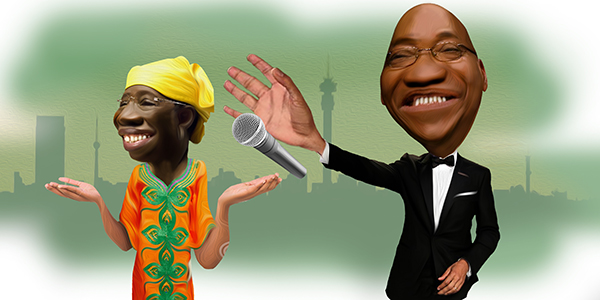Cape Town, South Africa – THE SUCCESSION WILL NOT WAIT FOR THE STARTING GUN
The starting gun has yet to go off, but that hasn’t stopped the campaigns to succeed President Jacob Zuma at Union Buildings from racing ahead.
At the end of January this year, South Africa’s ruling party, the African National Congress finally announced the exact date of the party’s 54th National Conference in December 2017, and by so doing, drew a line under the phony war between factions of the party for what I am calling the Zuma Succession.
Like the original ‘phony war’– the derisive term given by journalists to the period from October 1939 when Germany invaded Poland to March 1940 when no land operations were undertaken by either the Allies or the Germans – the phony ANC war among those most likely to succeed President Jacob Zuma at the helm of the continent’s oldest liberation movement has seen no real action and has been a time when the various factions of the party have been busy testing the waters to measure support for their preferred candidates in the battle to come.
The phony ANC war among those most likely to succeed President Jacob Zuma at the helm of the continent’s oldest liberation movement has seen no real action and has been a time when the various factions of the party have been busy testing the waters
According to a statement from the party’s headquarters at the end of a three-day National Executive Committee (NEC) meeting on January 27, ‘The National Conference will be held from December 16-20 in Gauteng.’
And while officially the party has announced a roadmap to be taken before potential candidates can begin to marshal their forces to lobby for support for leadership positions at the conference in December, in reality the race has been on ever since October 2015, when President Zuma declared he would not be standing for an extra term as president of the party.
The ANC’s conventions dictate that hopefuls for party posts should not campaign for themselves and that their supporters should wait for nominations to be made at branch level, which in this case would be in September and October this year.
As the party battles to contain political factions from jumping the gun ahead of its elective conference in December, Secretary General Gwede Mantashe did not seem to help matters when he said recently that the party would have to ask itself difficult questions if it did not elect its deputy president to succeed the outgoing president.
The Business Day news website quoted Mantasheas saying: ‘Now, I don’t want us to create traditions that do not exist, but when we elect a deputy president, you should be having succession in mind, that’s a more correct argument. Once you have a deputy and you elect someone else, you ask yourself difficult questions: Is this deputy not competent enough to be the successor?’
At the party’s NEC in January, all the unofficial campaigning and strategising by the various factions and their putative candidates was supposed to have been rendered a false start. However, it is clear that unlike at the Olympics, nobody appears to have been disqualified for jumping the gun.
It is generally agreed among political commentators and analysts that the ANC is split into two broad camps. These are the so-called tenderpreneur faction and the ‘reformist’ faction.
A SPANNER AMONG THE TENDERS
Nevertheless, the president’s 2015 statement about standing down, did throw a spanner in the works for the tenderpreneur faction that had reportedly been working on the premise that Zuma would hang on as the party’s head, until the party’s National Governing Council meeting of 2019.
This group hoped that by so doing, Zuma would help the party harmonise its presidential term with that of the national government.
However, this faction seems to have fallen foul of the principle of political uncertainty, which is contrary to Isaac Newton’s clockwork universe, where everything follows clear-cut laws on how to move and prediction is easy if you know the starting conditions. The political uncertainty principle makes such prediction very fuzzy.
Now, I don’t want us to create traditions that do not exist, but when we elect a deputy president, you should be having succession in mind, that’s a more correct argument- ANC Sec-Gen Gwede Mantashe
It would seem however that not all was lost for the group. Their main aim is to prevent Zuma being succeeded by trade unionist-turned democracy negotiator, turned uber-successful businessman and deputy leader of both the party and the country, Cyril Ramaphosa. If Zuma won’t hang on, then their plan B is for a woman to succeed Jacob Zuma and for this campaign they have the backing of the powerful ANC Women’s League.
By the way, their candidate is not just any woman, but NkosazanaDlamini- Zuma, until recently the head of the African Union and an ANC heavyweight in her own right. She was also once married to President Jacob Zuma.
Interestingly, President Zuma himself has for some time been suggesting that it was time South Africa had a female president – a move which has been seen by his supporters as being outright backing for Dlamini-Zuma.
In fact, one commentator, Susan Booysen, a professor at the Wits School of Governance, suggested as far back as 2014 that the plan was for Dlamini-Zuma to be parachuted into the party presidency via the creation of a position of second deputy president, as a way to dilute Ramaphosa’s standing.
The tenderpreneur faction represents the status quo. However, recently, it was reported that the pro-Zumafaction may be reconsidering their backing for Dlamini-Zuma because she appears to have reservations about having her own reputation and legacy tainted by being seen to favour them. The former AU chair has reportedly been unwilling to give any undertakings that she will pander to their agenda.
THE WIFE IS HER OWN WOMAN, IT SEEMS
Dlamini-Zuma may have been married to Jacob Zuma once and may still have cordial ties with him, but she has also been known to chart her own political path and at times this has been one diametrically opposed to the president’s.
According to one analyst, ‘There are apparently also concerns, including from the president, that Dlamini-Zuma still maintains a close relationship with former president Thabo Mbeki. It is still a sticky point that at the ANC’s Polokwane Conference in 2007, Dlamini-Zuma featured on both the Zuma and Mbeki slates but she declined the Zuma camps’ nomination and stood on Mbeki’s ticket.’
While it is common knowledge that Zuma and his predecessor Mbeki see eye to eye on very little if anything at all, the one thing that is generally agreed by political observers is that both men have showed an antipathy to their deputy ascending to the top job. Earlier in the year,Zuma told interviewers from the SABC that it was not ANC policy or tradition that an ANC deputy president should automatically replace a president during an elective conference.
In Kwa Zulu Natal, a hotbed of Zuma support, there is open opposition to Ramaphosa in the ANC ranks. Ramaphosa has also been vigorously opposed by the ANC Women’s League, the party’s Youth League and the uMkhonto we Sizwe (abbreviated as MK) Veterans league. All of these groupings have already pronounced Dlamini-Zuma as their preferred candidate to succeed Jacob Zuma both as party and national president.
Conventionally, the ANC prefers that aspirants not promote their own candidacy and instead pushes for nominations to be made at branch level. Of course, in these situations, what the party would prefer and what actually happens tend to be two different things.
On the other hand, the traditions of the ANC, which have seen the deputy president ascend to the presidency, suggest that the scales are tipped in favour of the ‘reformists’ who back Ramaphosa. However, Ramaphosa’s silence on important matters have caused him to be seen as aloof.
THE JOHANNESBURG CANDIDATE
Nevertheless, and for whatever it may count for the voters in the party’s election, in the boardrooms of the firms that make up the Johannesburg Stock Exchange,Ramaphosa is the best candidate. He has also been endorsed by the Congress of South African Trade Unions (Cosatu) a powerful bloc in the tripartite alliance (which also comprises the ANC and the South African Communist Party) that has enormous influence on who eventually takes over the ANC leadership.
Already the undeclared contest for the top job has caused friction among the party cadres. For instance, an NEC member has already publicly put down the Youth League president, Collen Maine, for going ahead to endorse ‘certain leaders for the presidency without the mandate to do so.’
It is generally agreed that the ANC is split into two broad camps:The so-called tenderpreneur faction and the ‘reformist’ faction
But as the factions square up against each other in the phony war, seasoned Zuma watchers are expecting the wily old operator to have an agenda for his own succession very different from the one ascribed to him in the current accepted narrative. It is entirely possible that Zuma’s ready support for Dlamini-Zuma is all smoke and mirrors to cover the identity his real preferred successor.
There have been suggestions that the president’s support for Dlamini-Zuma over Ramaphosa is calculated and that he is fully expecting Dlamini-Zuma to be rejected because of her perceived close ties to him and that this would then prepare the ground for a ‘compromise’ candidate who would be the person Zuma has wanted to take over from him all along.
The question, however, is just who this ‘dark horse’ candidate could be if he or she even exists?
Other than Dlamini-Zuma and Ramaphosa, there have been other names mentioned as possible successors to President Zuma. The frontrunners among these are Speaker of parliament BalekaMbete and Home Affairs Minister MalusiGigaba.
Mbete, who is seen as close to the president, would fit the mould of a female successor and has already made statements to suggest that she may fancy a shot at the main chance. In April last year, a commentator on the Daily Maverick website,RanjeniMunusamy, wrote that the Speaker, who also happens to be ANC chairwoman, appeared, at that time anyway, to have the support of the ‘premier league,’ an informal grouping associated with President Zuma and that she had spoken of having had ‘many people’ approach her to run for the ANC president’s job.
THE YOUTH LEAGUE FACTOR
Gigaba, on the other hand, would fit into the narrative where some ANC members have been calling for generational change at the top of the party. Born in 1971, Gigaba is a former president of the ANC Youth League, which over the years has come to be viewed as an influential component within the broader ANC, one that provides a training ground for future ANC leaders. Nelson Mandela and Julius Malema, now head of the opposition Economic Freedom Front party, were also former presidents of the league. Gigaba too has said he is not averse to suggestions that he lead the party, hinting during an interview in August 2016 that while it was not up to him to decide who became the next leader, he was available.
https://www.youtube.com/watch?v=tqC44XldMvY
That said, the big money at the moment is on either Ramaphosa or Dlamini-Zuma. They are the foremost candidates and also the two with the most to prove.
The pro-Zuma factions of the party would like to see his legacy continued by Dlamini-Zuma while the anti-Zuma camp are backing Ramaphosa hoping he will rid the party of Zuma’s legacy of perceived corruption.
Below are biographies of both the leading hopefuls in the Zuma Succession race. The profiles were compiled from multiple sources:
Cyril Ramaphosa
Cyril Ramaphosa was born on November 17,1952.
He was elected Secretary General of the African National Congress in 1991. He is widely respected as a skilful negotiator and strategist, and played a leading role as an ANC negotiator at CODESA (Convention for a Democratic South Africa).
He is also known for the role he played in building up the National Union of Mineworkers into the biggest trade union in South Africa.
Following the first democratic elections in 1994, Ramaphosa became a Member of Parliament. He was elected chairperson of the Constitutional Assembly on May 24,1994 and played a central role in the drafting of the South African Constitution.
Many expected him to go straight into national politics, but it was not to be. The story goes that he wanted to become Nelson Mandela’s deputy in 1994, and that when Mandela overlooked him, he became so upset that he refused to attend Mandela’s inauguration as president and he also declined a post in government.
If he could not be king in the political realm, he would conquer the economic one.
After leaving mainstream politics, Ramaphosa became the symbol of black capitalism in South Africa. Among other positions, he is executive chairman of Shanduka Group, a company he founded. Shanduka Group has investments in the resources sector, energy sector, real estate, banking, insurance, and telecoms (SEACOM). He is also chairman of the Bidvest Group and MTN. His other non-executive directorships include MacsteelHoldings, Alexander Forbes, Standard Bank and SABMiller. In March 2007, he was appointed non-executive joint chairman of Mondi, a leading international paper and packaging group, when the company demerged from Anglo American plc.
There have been suggestions that the president’s support for Dlamini-Zuma over Ramaphosa is calculated and that he is fully expecting Dlamini-Zuma to be rejected
Today, according to a BBC profile, Ramaphosa is the second richest black businessman in South Africa, with global financial publication Forbes putting his wealth at $675million. (The richest black businessman just happens to be his brother-in-law, Patrice Mostsepe.)
Ramaphosa always kept a foothold in the ANC, serving on its top leadership body, the NEC – a position that, his critics say, gave him insider information and unparalleled access to government ministers as he built his business empire.
The BBC wrote of him: ‘These accusations grew after police killed 34 workers in August 2012 at the Marikana platinum mine – the most deadly police action since white minority rule ended.
‘With Mr Ramaphosa a director in Lonmin– the multinational that owns the mine – he was accused of betraying the workers he once fought for, especially after e-mails emerged showing he had called for action against the miners for engaging in “dastardly criminal acts” – an apparent reference to their wildcat and violent strike.’
Although to some his reputation was tarnished, his election as ANC deputy leader showed he retained massive support among the party’s rank and file, dating back to his role in the struggle against apartheid.
His nomination for the post was supported by influential figures in the National Union of Mineworkers, which he founded in 1982, as well as the South African Communist Party – a clear sign that, despite his wealth, they do not believe he has abandoned his roots.
Nkosazana Clarice Dlamini-Zuma
Born on January 27,1949 in KwaZulu-Natal, South Africa, NkosazanaDlamini-Zuma is the immediate former Chairperson of the African Union. Previously, she served as the South African minister of home affairs.
She is a longstanding heavyweight in the ANC, boasting anti-apartheid struggle credentials as an underground member of the party when it was still banned. Some of these positions include being a member of the NECand the party’s National Working Committee. She is also a member of the Women’s League NEC and the National Progressive Women’s Movement of South Africa.
A medical doctor by training, Dlamini-Zuma was married to President Jacob Zuma from 1972 to 1998. The couple met in exile in Swaziland, during the depths of the apartheid era. In 1972, Dlamini-Zuma became Zuma’ssecond wife and the couple went on to have four children.
Though divorced, they are seen to still enjoy good relations, often shaking hands and hugging in public at ANC events or government conferences. Nevertheless, their political relationship has been through ups and downs with Ms Dlamini-Zuma at times seeming to back her former husband, and at other times overtly siding against him.
Dlamini-Zuma went on to become democratic South Africa’s first health minister between 1994-1999, having been appointed by Nelson Mandela. His successor, Thabo Mbeki, put her in charge of foreign affairs, where she worked to implement his much-derided ‘quiet diplomacy’ with neighbouring Zimbabwe as it sank into a deep crisis under President Robert Mugabe.
In Zuma’s administration, she served as home affairs minister, where she was credited with reform of a department mired in bureaucracy and corruption, before she took the African Union Commission posting in 2012.
The soft-spoken Dlamini-Zuma appears to lack the easy charm and common touch that her former husband has used so effectively to shore up his support, and she still must overcome widespread prejudice over her gender.
According to a BBC profile, the suspicion, now openly articulated by President Zuma’s opponents, is that the current South African leader is actively promoting his ex-wife’s bid to replace him, in the belief that as president, she will be able and willing to protect him from what he sees as a range of politicallymotivated legal challenges and corruption investigations that could well pursue him after he leaves office.
Ms Dlamini-Zuma will have to position herself as something other than a continuity candidate if she is not only to win December’s vote, but to convince South Africans that after nearly a quarter of a century in power, the ANC still deserves to remain in power come 2019.








